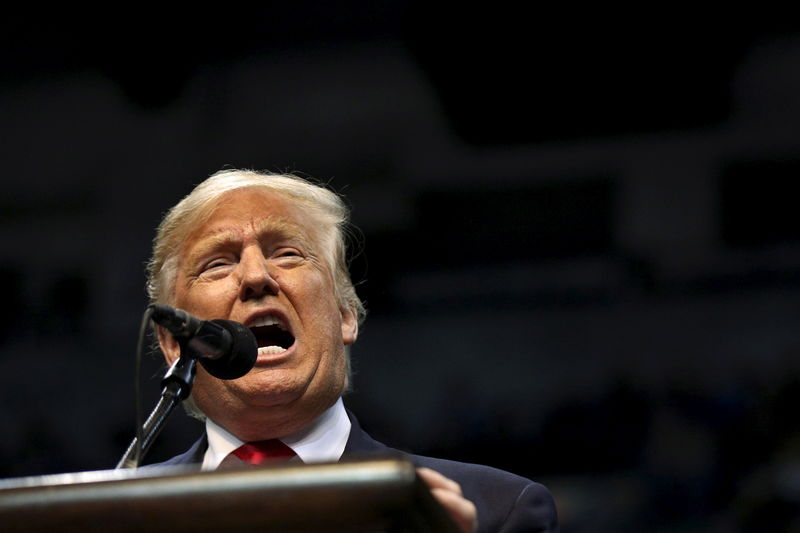Investing.com - Here are the top five things you need to know in financial markets on Friday, March 2:
1. Trade tensions slam global stocks
Trade tensions continued to hammer global stocks on Friday after U.S. President Donald Trump said a day earlier that the United States would impose import tariffs on steel and aluminum, raising concern about higher prices and a trade war.
Trump said duties of 25% on steel and 10% on aluminum would be formally announced next week, sparking concerns of retaliatory moves from major trade partners such as China, Europe and neighboring Canada.
Wall Street closed more than 1% lower on Thursday and losses quickly spread to Asian stocks on Friday, with Japan’s Nikkei 225 tumbling more than 2.5%.
The trade tensions also pushed European stocks to a two-week low on Friday with the pan-European Stoxx 600 down around 1%.
U.S. futures pointed to a continuation of the selloff on Friday. At 5:43AM ET (10:43GMT), the blue-chip Dow futures fell 124 points, or 0.52%, S&P 500 futures lost 10 points, or 0.35%, while the Nasdaq 100 futures traded down 33 points, or 0.44%.
2. Gold jumps as trade fears spark flight to safety
Gold prices rebounded on Friday, bouncing off a two-month low as news of U.S. tariffs on steel and aluminum imports spooked investors, encouraging them to flock toward safer assets.
Comex gold futures were up 1.03% at $1,318.70 a troy ounce by 5:44AM ET (10:44GMT), off Thursday's two-month trough of $1,303.60.
Concerns over a harmful trade war eclipsed upbeat U.S. economic data published on Thursday, including a rise in the manufacturing index to 14-year highs and another showing the number of Americans filing for unemployment benefits hitting a 48-year low.
Friday’s session will be light in economic data with investors focusing on the revision to the University of Michigan’s consumer sentiment index for February to be released at 10:00AM (15:00GMT).
3. BoJ governor hints at exit from ultra-loose monetary policy
Japan's central bank chief said on Friday it would consider ending ultra-loose monetary policy if inflation hits its target during the year ending in March 2020, in comments that sent the yen higher and triggered a bond sell-off.
"The BOJ's board members expect that prices will reach 2 percent around fiscal 2019. If this happens, there's no doubt that we will consider and debate an exit," Bank of Japan Governor Haruhiko Kuroda told parliament.
The dollar fell against the yen and Japanese government bond prices slipped following the remark, which triggered market expectations the BOJ would follow in the footsteps of its major peers in whittling down crisis-mode monetary stimulus earlier than expected.
4. British PM to seek unity on Brexit
UK Prime Minister Theresa May will seek to unify warring sides in Britain over the Brexit as she seeks to outline her vision of the trade deal she wishes to strike with the European Union.
“We must bring our country back together, taking into account the views of everyone who cares about this issue, from both sides of the debate”, she will say according to excerpts of a speech scheduled to be delivered Friday at 8:30AM ET (13:30GMT).
May is expected to attempt to unify her own divided party and public opinion as the UK continues to negotiate its separation from the EU.
The British Prime Minister is set to outline her vision on Friday for a Brexit deal deeper and wider than any "free trade agreement anywhere in the world", telling the European Union it is in their "shared interest".
In the much-anticipated speech which the EU hopes will offer details of her plan for Britain's future after Brexit, May will try to defuse a dispute over the border with Ireland that threatens to stall the Brexit talks.
5. Oil on track for weekly losses of 4%
Crude oil prices were still under pressure on Friday, amid ongoing concerns over U.S. production levels and fresh worries over U.S. protectionist policies.
U.S. crude oil futures fell 0.44% to $60.72 at 5:45AM ET (10:45GMT) Friday, while Brent oil lost 0.36% to $63.60.
Fears that rising U.S. output could dampen OPEC-led efforts to rid the market of excess supplies have systematically put downward pressure on oil prices. The U.S. benchmark was on track for weekly losses of around 4.5% while the global benchmark Brent was down around 5.3% in the last seven days.
Later on Friday, market participants will pay close attention to incoming data on U.S. shale production when Baker Hughes releases its most recent weekly rig count.
